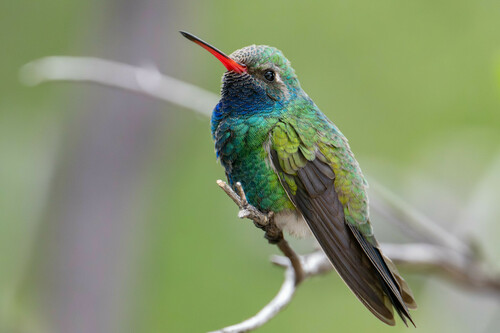
Broad-billed Hummingbird
The Broad-billed Hummingbird (*Cynanthus latirostris*) is a visually striking hummingbird species known for its vibrant coloration and relatively broad bill. It plays a crucial role in its ecosystem as a pollinator, contributing to the health and diversity of plant life in its range. While not globally threatened, it faces localized challenges due to habitat loss and degradation. The species holds no widespread specific cultural significance, but like all hummingbirds, it is often admired for its beauty and agility.
8-10 cm
Length
11-13 cm
Wingspan
Least Concern
Conservation Status
Distribution
The Broad-billed Hummingbird breeds from southeastern Arizona, southwestern New Mexico, and extreme western Texas in the United States, south through much of Mexico. Northern populations are migratory, withdrawing to central and southern Mexico for the winter. They are found from sea level to elevations of around 2,000 meters (6,500 feet).
Lifespan
Average lifespan in the wild is not well-documented but is estimated to be 3-5 years. Some individuals may live longer.
Broad-billed Hummingbird's Habitat
Habitat Types
Riparian woodlands, Canyon scrub, Thorn forests, Gardens, Suburban areas with flowering plants
Climate Zones
Subtropical, Temperate
Adaptations
Their relatively broad bill is adapted for feeding on a variety of flowers, and their small size allows them to access nectar sources that larger birds cannot. They are also capable of entering torpor, a state of reduced metabolic activity, to conserve energy during cold nights or periods of food scarcity.
Variations
Several subspecies are recognized, differing slightly in plumage and size. These variations are primarily based on geographic location within Mexico.
Appearance
Breeding Plumage
Males have a bright metallic green body, a brilliant blue throat (gorget), and a red bill with a black tip. Females are less colorful, with a duller green back and a grayish-white underside. There is no significant seasonal variation in plumage beyond general wear and tear.
Seasonal Feather Changes
No significant seasonal variations.
Sex Based Plumage Differences
Highly pronounced. Males are much more colorful than females.
Notable Features
Broad, red bill with a black tip (in males), Bright blue gorget (in males), Metallic green body (in males), White undertail coverts
Diet and Feeding
Primary Foods
Nectar from flowering plants, Small insects, Spiders
Foraging Behavior
Broad-billed Hummingbirds are primarily nectarivores, feeding by hovering in front of flowers and extending their long, slender tongues to extract nectar. They also glean insects and spiders from foliage and occasionally catch them in mid-air (hawking).
Specializations
Their long, slightly curved bill and specialized tongue are adapted for reaching nectar deep within flowers. Their ability to hover allows them to access flowers that are inaccessible to other birds.
Seasonal Diet Variations
During the breeding season, they consume more insects to provide protein for growing chicks. In winter, they rely more heavily on nectar sources, although insect consumption continues.
Behavior
Social Structure
Generally solitary, except during breeding season. Males are highly territorial and will aggressively defend feeding territories from other hummingbirds.
Communication
High-pitched chattering calls, Buzzing sounds produced by wings during flight and displays, Visual displays, including showing off the gorget
Migration
Northern populations are migratory, moving south to central and southern Mexico for the winter. The timing and routes of migration are not fully understood but are likely influenced by food availability and weather patterns.
Territorial or Group Behaviors
Males are highly territorial, especially around flowering plants. They will chase away other males and even females after mating. Females also defend small territories around their nests.
Conservation
Threats
Habitat loss and degradation due to agriculture, urbanization, and logging, Pesticide use, which can reduce insect prey and potentially poison hummingbirds, Climate change, which can alter flowering patterns and affect nectar availability
Protection Programs
Some protected areas exist within their range, providing habitat for breeding and foraging., Efforts to promote hummingbird-friendly gardening practices.
Local National Laws
Protected under the Migratory Bird Treaty Act in the United States.
Population Trend
Stable
Population Estimates
While precise numbers are difficult to obtain, the global population is estimated to be in the millions.
Interesting Facts
They can beat their wings up to 50 times per second.
This rapid wingbeat allows them to hover and maneuver with precision while feeding.
They can fly backward.
Hummingbirds are the only group of birds that can fly backward, a skill that helps them navigate around flowers.
They have a very high metabolic rate.
To fuel their high-energy lifestyle, they need to consume large amounts of nectar and insects relative to their size.
The male's bright blue throat patch is called a gorget.
This iridescent gorget is used in courtship displays and territorial defense.
Faqs about Broad-billed Hummingbird
What can I do to attract Broad-billed Hummingbirds to my yard?
Plant native flowering plants, especially those with red, tubular flowers. Provide a hummingbird feeder with a sugar-water solution (1 part sugar to 4 parts water), and avoid using pesticides.
How can I tell the difference between a male and a female Broad-billed Hummingbird?
Males have a bright blue throat and a red bill with a black tip, while females have a duller green back, a grayish-white underside, and a less distinctively colored bill.
Do Broad-billed Hummingbirds return to the same nesting site each year?
While they may return to the same general area, they typically build a new nest each year.
How do they survive cold temperatures?
They can enter a state of torpor, lowering their body temperature and metabolic rate to conserve energy.
Copyright @ Nature Style Limited. All Rights Reserved.
 English
English